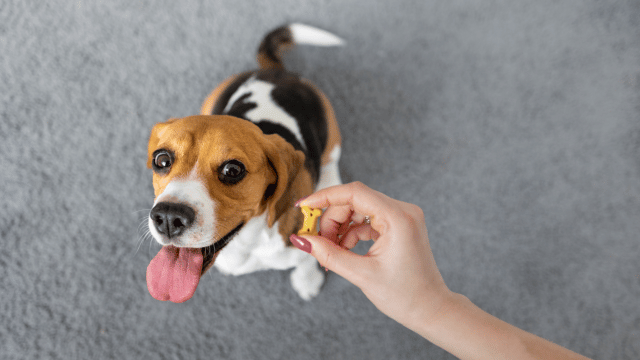Explore the effectiveness of Positive Reinforcement Dog Training in shaping canine behavior. This approach fosters a strong, positive bond between dogs and their owners.
Understanding Basics of Positive Training Methods

Positive Reinforcement Dog Training revolutionizes how we interact with our canine companions. This method, rooted in behavioral science, emphasizes rewarding desirable behaviors rather than punishing unwanted ones. Significantly, it creates a learning environment based on trust and mutual respect. This approach not only enhances training effectiveness but also strengthens the emotional bond between dogs and their owners, making it a widely recommended technique by experts.
The core principle of Positive Reinforcement Dog Training lies in its reward-based system. When a dog performs a desired behavior, they receive a reward – often a treat, praise, or playtime. This positive outcome encourages them to repeat the behavior. Conversely, undesired actions are not rewarded, thus diminishing their occurrence over time. This method, therefore, relies on the dog’s natural inclination to seek out pleasant experiences, effectively shaping their behavior.
Implementing Positive Reinforcement Dog Training requires patience, consistency, and an understanding of canine psychology. It’s crucial to identify what motivates each individual dog, as this varies significantly. Some respond well to treats, while others prefer toys or verbal praise. Tailoring the rewards to the dog’s preferences ensures a more effective and enjoyable training experience for both the dog and the trainer.
Building Trust Through Positive Reinforcement Techniques
A fundamental aspect of Positive Reinforcement Dog Training is building a trusting relationship. Trust forms the foundation of effective training, as dogs learn best when they feel safe and understood. This method avoids fear or intimidation, focusing instead on encouraging and rewarding good behavior. Consequently, dogs become more eager to learn, responding with enthusiasm to training sessions, and developing a deeper bond with their trainers.
Positive Reinforcement Dog Training also emphasizes the importance of timing and consistency. The reward must be given immediately after the desired behavior to create a clear association in the dog’s mind. Consistent practice and reinforcement are vital; irregular rewards can lead to confusion and slower learning. Hence, a regular, predictable training schedule enhances the dog’s understanding and adherence to the desired behaviors, making training more efficient and effective.
Besides treats and praise, Positive Reinforcement Dog Training employs various tools to aid in teaching. Clickers, for instance, are popular for their effectiveness in marking the exact moment a dog performs correctly. This sound-based tool helps dogs understand precisely which behavior earned them a reward. Such tools, combined with verbal cues and gestures, provide a multifaceted approach to training, catering to different learning styles and preferences.
Maximizing Effectiveness in Positive Reinforcement Training

To maximize the effectiveness of Positive Reinforcement Dog Training, it’s crucial to understand each dog’s unique personality and learning pace. Some dogs may grasp commands quickly, while others need more time and repetition. Patience is key. Adapting the training pace to the dog’s individual needs ensures a stress-free and productive learning environment. This adaptability fosters a more positive training experience and accelerates learning progress.
Another aspect of enhancing Positive Reinforcement Dog Training is the use of varied rewards. While some dogs are food-motivated, others may prefer toys or affection. Rotating rewards can prevent boredom and maintain the dog’s interest in training sessions. Furthermore, progressively reducing the frequency of rewards as the dog learns can encourage them to perform behaviors more consistently, even without the immediate prospect of a reward.
Lastly, Positive Reinforcement Dog Training isn’t just about training the dog; it’s also about educating the owner. Owners need to learn how to communicate effectively with their pets, understand canine body language, and consistently apply the principles of positive reinforcement. This holistic approach not only improves the dog’s behavior but also enhances the owner’s skills, leading to a more harmonious and enjoyable relationship between them.
Overcoming Challenges in Positive Training Methods
While Positive Reinforcement Dog Training is highly effective, it’s not without challenges. One common issue is over-reliance on treats, which can lead to weight gain. To avoid this, trainers can use small, low-calorie treats or portions of the dog’s regular meals. It’s also important to gradually transition from continuous to intermittent reinforcement, ensuring that the dog responds to cues even without the promise of a treat.
Another challenge is managing distractions during training. Dogs, especially young or energetic breeds, can easily be distracted by their environment. To combat this, start training sessions in a quiet, controlled space. Gradually introduce more distractions as the dog becomes proficient in responding to commands. This gradual increase in difficulty helps the dog learn to focus and obey commands in various settings, ensuring well-rounded training.
Consistency is crucial in Positive Reinforcement Dog Training, yet it can be hard to maintain. Inconsistent commands or rewards can confuse the dog. Therefore, all family members should be on the same page regarding training techniques and commands. Consistent application of rules and cues across different scenarios and by different people helps the dog understand and adhere to the expected behaviors more reliably.
Enhancing Dog Behavior with Positive Technique
Positive Reinforcement Dog Training goes beyond teaching basic commands; it plays a crucial role in shaping overall dog behavior. Good behavior encouraged through positive reinforcement often translates to various aspects of a dog’s life, leading to better social interactions and reduced anxiety. Dogs trained with these methods tend to exhibit less aggression and fear, showcasing a balanced and healthy temperament, beneficial for both the dog and the community.
Integrating Positive Reinforcement Dog Training into daily routines can also significantly enhance its effectiveness. Instead of designated ‘training times,’ owners can use everyday situations to reinforce good behavior. This approach makes training a continuous, natural part of the dog’s life. For example, asking for a sit before meals or a calm wait at the door reinforces discipline and obedience seamlessly into their daily routine.
Positive Reinforcement Dog Training also lays the foundation for addressing more complex behavioral issues. By establishing trust and a line of clear communication, it becomes easier to tackle problems like excessive barking, chewing, or separation anxiety. With patience and consistency, these methods allow for gradual, stress-free correction of unwanted behaviors, ensuring a well-adjusted and happy dog.
Strengthening Owner-Dog Bond with Positive Training
Positive Reinforcement Dog Training does more than just teach commands; it strengthens the bond between dogs and their owners. This training approach is based on mutual respect and understanding, fostering a deeper emotional connection. Owners become more attuned to their dogs’ needs and personalities, while dogs learn to trust and respond more keenly to their owners. This enriched bond is a fundamental benefit of positive training methods.
An integral part of strengthening this bond is the owner’s active involvement in the training process. When owners take the time to train their dogs, it’s not just about imparting skills; it’s also about spending quality time together. This shared activity promotes better communication and understanding. It’s an opportunity for owners to observe and appreciate the unique traits and intelligence of their canine companions.
The success of Positive Reinforcement Dog Training largely depends on consistency and empathy from the owner’s side. By consistently applying positive reinforcement techniques and showing empathy towards their dogs, owners exemplify patience and caring. This approach not only aids in effective training but also assures the dog of a safe and nurturing environment, further cementing the trust and affection in the owner-dog relationship.
Long-Term Benefits of Positive Training Methods
The long-term benefits of Positive Reinforcement Dog Training are profound and multifaceted. Dogs trained with this method tend to retain learned behaviors longer, as the training is associated with positive experiences. This longevity of learning means that the positive behaviors become ingrained habits, contributing to a well-behaved dog throughout its life. This enduring effect underscores the efficacy of positive reinforcement in shaping a dog’s behavior over time.
Beyond behavior, Positive Reinforcement Dog Training positively impacts a dog’s mental health. Dogs trained in a positive, stress-free environment are generally happier and more relaxed. They exhibit fewer signs of anxiety and stress, leading to a better quality of life. This mental well-being is essential for a dog’s overall health, as it can prevent many behavior-related issues commonly seen in dogs.
Positive Reinforcement Dog Training also benefits the owner in the long run. It equips owners with the skills to effectively communicate with their dogs, leading to easier management and fewer behavioral problems. Additionally, the training process itself can be highly rewarding and enjoyable for the owner, enhancing their overall experience of pet ownership. This method creates a harmonious living situation for both the dog and its owner.
Effective Communication Key in Dog Training Success
Eighth Section (3 paragraphs, 68 words each):
Effective communication is the cornerstone of Positive Reinforcement Dog Training. Understanding and being understood by your dog are fundamental for successful training. This method relies on clear, consistent signals to communicate what is expected from the dog. By using specific commands, gestures, and rewards, owners can convey their instructions in a way that is easily comprehensible to their dogs, facilitating smoother training sessions and better outcomes.
Positive Reinforcement Dog Training not only teaches dogs how to behave but also educates owners on how to listen to their pets. Recognizing subtle cues in body language, barking patterns, and general behavior helps owners understand their dogs’ needs and emotions. This two-way communication enhances the training process, as it allows owners to adjust their methods according to their dog’s responses, leading to more effective training.
The beauty of Positive Reinforcement Dog Training lies in its emphasis on a respectful and empathetic approach. This method encourages owners to see things from their dog’s perspective, promoting a deeper understanding and a stronger bond. Training becomes a joint endeavor, a dialogue rather than a monologue, where both the dog and the owner learn and grow together.
Adapting Training to Each Dog’s Unique Needs

A key advantage of Positive Reinforcement Dog Training is its adaptability to each dog’s unique personality and needs. Unlike one-size-fits-all methods, this approach allows for customization. By observing and understanding individual behavioral patterns and preferences, trainers can tailor their techniques. This personalized approach not only makes training more effective but also ensures that it is a positive and enjoyable experience for each dog, catering to their specific learning style.
This adaptability extends to addressing different types of behaviors, from basic obedience to more complex issues. For instance, a dog with a timid nature might require gentler reinforcement and more patience, while an energetic dog might need more engaging and dynamic training sessions. Recognizing these differences and adjusting the training accordingly is crucial for success, as it helps in effectively communicating the desired behaviors to each dog.
Furthermore, Positive Reinforcement Dog Training promotes lifelong learning. It encourages owners to continuously assess and adapt their training strategies as their dogs grow and change. This ongoing process not only helps in maintaining learned behaviors but also in introducing new skills and challenges, keeping the dog mentally stimulated and engaged. This dynamic aspect of training underscores the versatility and effectiveness of the positive reinforcement approach.
Positive Training: A Path to Harmonious Living
Positive Reinforcement Dog Training isn’t just about obedience; it’s a pathway to a harmonious living situation between dogs and their owners. This approach fosters a respectful and understanding relationship, where commands are not just followed, but willingly and happily complied with. This harmony extends beyond training sessions, influencing everyday interactions and creating a peaceful, cooperative atmosphere in the home.
The impact of this training method on household dynamics is significant. Dogs trained with positive reinforcement tend to be well-adjusted and less prone to destructive behaviors, making cohabitation smoother and more enjoyable. This positive behavior influences the overall energy of the home, contributing to a calmer and more structured environment. It’s a method that not only trains dogs but also brings balance and order to the household.
In conclusion, Positive Reinforcement Dog Training is more than a technique; it’s a philosophy that promotes understanding, patience, and empathy. It’s a commitment to building a relationship based on mutual respect and love, resulting in well-behaved dogs and satisfied owners. This method doesn’t just create obedient pets; it nurtures well-rounded companions, integral to a happy and harmonious home.
In summary
Positive Reinforcement Dog Training is a powerful and effective approach, offering numerous benefits for both dogs and their owners. It transcends traditional training methods by fostering a positive and respectful relationship, where learning is a pleasant and rewarding experience. This technique not only encourages good behavior but also nurtures a deep bond based on mutual trust, understanding, and affection.
The versatility of this method allows it to be tailored to individual dogs, making it suitable for various personalities and behavioral needs. Its emphasis on clear communication and empathy positions it as more than just a training technique; it’s a way of life that enhances the overall wellbeing of dogs and enriches the pet ownership experience. The consistent application of this method leads to happier, well-adjusted dogs and satisfied owners.
Embracing Positive Reinforcement Dog Training paves the way for a harmonious and joyful living environment. It’s a testament to the power of positivity, respect, and understanding in shaping behavior. This approach doesn’t just create obedient dogs; it cultivates a lifestyle of harmony and cooperation, contributing to a peaceful coexistence. Ultimately, it’s about creating a lifelong, fulfilling relationship between dogs and their human companions.
I. Frequently Asked Questions About Dog and Cat Behavior
- What is the cat training method for dogs?The cat training method for dogs involves using positive reinforcement and rewards to encourage desired behaviors, similar to how one might train a cat, focusing on patience and understanding the dog's cues.
- Can dogs and cats be trained the same way?While some training principles like positive reinforcement apply to both, dogs and cats have different motivations and learning styles, necessitating tailored approaches for each.
- How are cats and dogs related?Cats and dogs are both mammals but belong to different families; cats to Felidae and dogs to Canidae. They share a predatory ancestry and have been domesticated by humans for different roles and companionships.
- How would you describe a dog and cat?Dogs are often described as loyal, social, and eager to please, thriving on companionship and activity. Cats are typically seen as independent, agile, and curious, valuing their personal space and engaging on their terms.
- How do cats and dogs live together?Cats and dogs can live together harmoniously with proper introduction, understanding of each other's body language, and respect for their individual needs and spaces.
- Why are cat and dog connected?Cats and dogs are connected in popular culture as common household pets, often depicted together to highlight their contrasting behaviors and relationships with humans.
- How long does it take a cat to get used to a dog?The time it takes for a cat to get used to a dog can vary widely, from a few days to several weeks, depending on the cat's personality, past experiences, and the dog's behavior.
- Can you get a dog and cat to live together?Yes, with careful introductions, understanding of their individual needs, and ongoing supervision, a dog and cat can live together peacefully.
- Is it okay to have a cat and a dog at the same time?Having a cat and a dog at the same time is okay and can be enriching for both pets and their owners, provided their individual needs are met and they are properly introduced.
- Can you keep dogs with cats?Yes, dogs and cats can coexist in the same household with proper management, training, and socialization to ensure they respect each other's boundaries.
Pictures of

Join Dan Morgan at dwfocus.com, your hub for ‘4 paws and owners’ wisdom! Explore a world where pet care meets expert insights, crafted by Dan, a seasoned vet with a heart for animals. Engage with stories, tips, and advice that every pet owner needs. From playful pups to graceful cats, Dan Morgan guides you through the joys and challenges of pet parenting. Embrace your love for pets with Dan’s expert guidance on dwfocus.com. #4PawsAndOwners #DanMorganPetExpert #dwfocus






